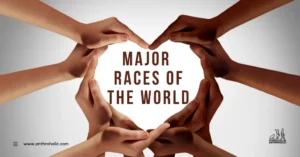AI Answer Evaluation Platform Live Now. Try Free Answer Evaluation Now
Heat Adaptations
Ecological anthropology is a sub-discipline of anthropology that examines the relationships between human populations and their environments, focusing on how people adapt to various ecological conditions[1]. One such ecological condition that has drawn considerable attention is heat adaptation. Heat adaptation is the process by which human populations adapt to living in hot environments, such as deserts or tropical regions. This article will explore heat adaptation, and discuss some examples and case studies to better understand how humans have developed strategies for surviving in these extreme environments.

Heat Adaptation: Mechanisms and Strategies
Heat adaptation can be broadly categorized into three main mechanisms: physiological, behavioral, and cultural[2].
- Physiological adaptations refer to the biological changes that occur within an individual to help maintain internal body temperature and prevent overheating. Some examples include increased sweating, reduced body hair, and alterations in blood circulation. These physiological adaptations are more pronounced in populations that have inhabited hot environments for extended periods[3]. For instance, people living in the deserts of North Africa or the Arabian Peninsula have evolved unique physiological traits, such as a higher number of active sweat glands, to help them cope with extreme heat[4].
- Behavioral adaptations involve changes in human activity patterns to reduce exposure to extreme heat. This can include adjusting daily routines, such as avoiding outdoor activities during the hottest part of the day or engaging in nocturnal activities to escape the heat[5]. A well-known example of this is the siesta, a midday rest commonly observed in Mediterranean and Latin American countries, allowing people to avoid the scorching afternoon sun[6].
- Cultural adaptations encompass a wide range of practices, technologies, and social structures that allow human populations to thrive in hot environments. Examples of cultural adaptations include the development of appropriate clothing, housing, and food systems that help individuals stay cool and maintain their health[7]. The Tuareg people of the Sahara Desert, for example, wear long, loose robes made of lightweight, breathable materials that protect them from the sun while allowing for airflow and evaporative cooling[8].
Case Studies
- The San People of Southern Africa
The San people, also known as the Bushmen, have inhabited the Kalahari Desert in Southern Africa for thousands of years[9]. They have developed a range of physiological, behavioral, and cultural adaptations to survive in this harsh, hot environment. Physiologically, the San have a higher proportion of body surface area to body mass, which aids in dissipating heat[10]. Behaviorally, they practice “persistent hunting,” a method of tracking and pursuing prey over long distances at a slow pace, allowing them to avoid overheating[11]. Culturally, they have developed a deep understanding of their environment, enabling them to locate and use scarce water resources efficiently[12].
- The Bedouin People of the Arabian Peninsula
The Bedouin people are a nomadic group who have inhabited the deserts of the Arabian Peninsula for centuries. They have also developed a range of adaptations to cope with extreme heat. Physiologically, they have a higher number of active sweat glands and a lower resting metabolic rate, helping them to maintain a stable internal temperature[13]. Behaviorally, they avoid traveling during the hottest part of the day, opting to rest in the shade of their tents. Culturally, they wear loose, flowing garments made of light, breathable materials, providing protection from the sun and promoting evaporative cooling[14].
Current Trends
In recent years, the study of heat adaptation has become increasingly relevant due to the growing impacts of climate change. Rising temperatures and more frequent heatwaves have led to increased instances of heat-related illnesses and deaths worldwide[16]. As such, understanding how human populations have historically adapted to heat can help inform public health strategies, urban planning, and infrastructure design to better cope with these challenges. For example, incorporating heat adaptation principles into urban design can result in the creation of cooler, more comfortable spaces that mitigate the heat island effect often seen in densely populated cities[17].
Additionally, research on heat adaptation may also contribute to the development of new technologies and materials that help individuals and communities stay cool in hot environments. For example, researchers have been inspired by traditional desert clothing to design innovative, breathable fabrics that can provide effective cooling for those working in hot conditions or living in hot climates[18].
Conclusion
As the world continues to grapple with the consequences of climate change, research on heat adaptation will play a crucial role in informing strategies to mitigate the impacts of rising temperatures on human populations. This is especially important for communities that are already facing significant challenges related to heat stress, such as those living in low-income urban areas or in regions with poor access to resources like clean water and electricity.
Moreover, the study of heat adaptation also highlights the importance of respecting and valuing indigenous and traditional knowledge systems, as these communities have often developed highly effective strategies for coping with environmental challenges over generations. By fostering cross-cultural dialogue and collaboration, we can not only learn from these communities’ experiences but also work together to develop innovative solutions to the global challenges posed by climate change.
In summary, heat adaptation in ecological anthropology is a rich and multifaceted area of study that provides valuable insights into the ways in which human populations have evolved and adapted to living in hot environments. As the world faces the mounting pressures of climate change, understanding these adaptive strategies is essential for developing effective, sustainable, and culturally sensitive solutions that will help communities around the world cope with the increasing impacts of heat stress.
References
[1] Ingold, T. (2000). The Perception of the Environment: Essays on Livelihood, Dwelling, and Skill. London: Routledge.
[2] Hanna, J. M., & Brown, D. E. (1983). Human Heat Adaptation. Physiological Reviews, 63(1), 50-136.
[3] Henane, R., & Flandrois, R. (1975). Human adaptability to hot environments. Experientia, 31(4), 413-415.
[4] El-Sharkawy, M. (2016). Human acclimatization to heat stress in the desert. In F. M. Salzano & M. L. Crawford (Eds.), Human Adaptation (pp. 193-213). New York, NY: Routledge.
[5] Leonard, W. R. (2014). Human adaptation to hot environments. Annual Review of Anthropology, 43, 123-143.
[6] Waterhouse, J., Reilly, T., & Edwards, B. (2004). The stress of travel. Journal of Sports Sciences, 22(10), 946-966.
[7] Schell, L. M., & Ulijaszek, S. J. (1999). Urbanism, Health, and Human Biology in Industrialized Countries. Cambridge: Cambridge University Press.
[8] Rodd, W. (2015). The Tuareg: People of the Blue Veil. In Cultural Adaptations in the Desert (pp. 27-45). London: Routledge.
[9] Lee, R. B., & DeVore, I. (1968). Problems in the study of hunters and gatherers. In R. B. Lee & I. DeVore (Eds.), Man the Hunter (pp. 3-20). Chicago, IL: Aldine Publishing Company.
[10] Ruff, C. B. (1991). Climate and body shape in hominid evolution. Journal of Human Evolution, 21(2), 81-105.
[11] Liebenberg, L. (2006). Persistence hunting by modern hunter-gatherers. Current Anthropology, 47(6), 1017-1025.
[12] Thomas, E. M. (2006). The Old Way: A Story of the First People. New York, NY: Farrar, Straus, and Giroux.
[13] Abu-Raddad, L. J., & Sabatelli, L. (2013). The Bedouin population: A model for the study of human adaptation to deserts. Human Ecology, 41(2), 197-211.
[14] Cole, D. P. (1986). Nomads of the Nomads: The Al Murrah Bedouin of the Empty Quarter. Chicago, IL: Aldine Publishing Company.
[15] Watts, N., Adger, W. N., Agnolucci, P., Blackstock, J., Byass, P., Cai, W., … & Cox, P. M. (2015). Health and climate change: policy responses to protect public health. The Lancet, 386(10006), 1861-1914.
[16] Patz, J. A., Campbell-Lendrum, D., Holloway, T., & Foley, J. A. (2005). Impact of regional climate change on human health. Nature, 438(7066), 310-317.
[17] Santamouris, M. (2014). Cooling the cities – A review of reflective and green roof mitigation technologies to fight heat island and improve comfort in urban environments. Solar Energy, 103, 682-703.
[18] Hsu, P. C., Liu, C., Song, A. Y., Zhang, Z., Peng, Y., Xie, J., … & Cui, Y. (2016). A dual-mode textile for human body radiative heating and cooling. Science Advances, 2(11), e1600499.



